Declarer play in bridge
Three common techniques used as declarer in bridge for winning extra tricks are suit establishment, finessing and ruffing. These are the building blocks of good declarer play.
Three techniques for successful declarer play
Suit Establishment - Simply winning tricks from your long suits. It's a technique that works equally well in notrump and suit contracts.
Finessing - With a finesse you're trying to win a trick even though the opponents have a higher card in the suit.
Ruffing - Playing a trump when another suit was led. Sometimes it's called trumping but ruffing is the right word.
Suit Establishment - winning extra tricks in a long
The opening lead against 3NT on the following hand is the ♦3. What's the best way to play the hand?
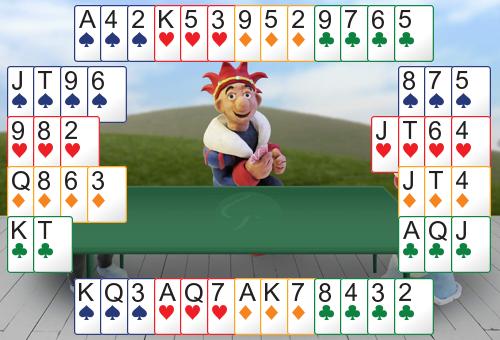
North and South have 8 clubs between the two hands leaving just 5 for East and West. If declarer keeps playing clubs then, eventually, East and West will run out of them.
Declarer wins the opening lead and immediately plays a club, losing the trick. Upon regaining the lead, delcarer plays another club, again losing the trick. Once more, declarer regains the lead and plays a club. The defence have now won three club tricks but declarer has established the last club as a winner.
East had 3 clubs and West had 2. That's called a 3-2 break and it will happen more often than not.
Establishing a long suit is also a common strategy when playing in a suit contract.
Learn more about bridge odds.
Notice how important it is for declarer to play clubs immediately while there are still stoppers in the other suits even although it means losing the lead.
Losing the lead
Losing the lead just for the sake of losing the lead isn't going to help. Our aim is to establish extra tricks and we only want to lose the lead if that is indeed going to help. Lose the lead so that opponents run out of cards in a suit.
Losing the lead is much less painful if we're likely to get the lead back again! That's what we need aces and kings for. To get the lead back again. Provided we have can regain the lead later then we can be fearless losing the lead now.
Suit Combinations
It's easiest to consider a finesse first.
Finesse
A finesse in bridge is a card play technique that can sometimes allow you to win a trick with a card that is not the highest one remaining in the suit. A finesse normally works by leading a low card from one hand, waiting to see what card second hand plays and then playing a high but, not the highest, card from the third hand hoping that fourth hand can't beat that card.
Simple Finesse
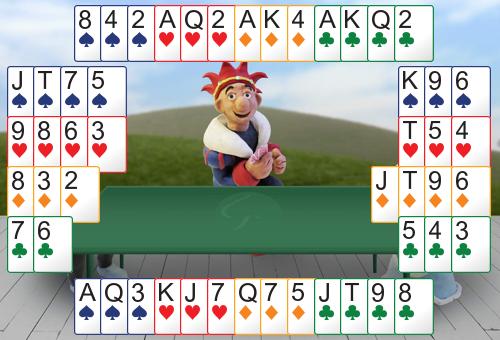
You are North and East leads a diamond against your contract of 6NT. You can count four sure club tricks, three diamond tricks and three heart tricks and therefore need two spade tricks to make the contract.
Play a low spade from the North hand and wait to see what East plays. If East plays low you play the ♠Q. West can't beat that card and you still have the ♠A for your 12th trick.
How do you know that East has the ♠K? You don't! You just have to hope. But if West has the ♠K then there's almost no way to make your contract so a winning finesse is all you can hope for.
There's a 50% chance that East started with the ♠K but only a very small chance West started with the singleton ♠K. A finesse doesn't guarantee and extra trick but it's often your best chance.
Learn about the double finesse.
Low to an honour
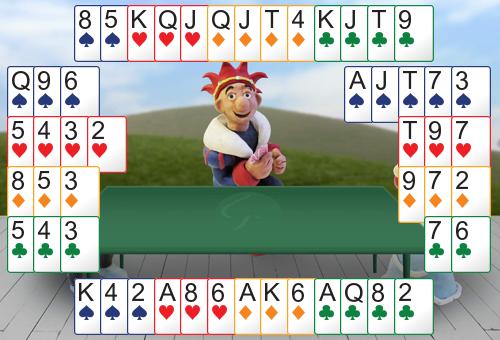
This time you are South in a contract of 6NT and West leads a diamond. This time you have four sure club tricks, three diamond tricks and four heart tricks. You need one spade trick.
Now you need to hope that East has the ♠A. Lead a low spade from the North hand. If East plays low you can play your ♠K and win the trick. If East plays the ♠A you play low from the South hand and your ♠K will take a trick later.
Running Finesse
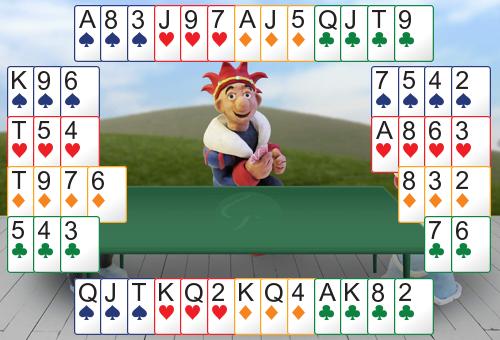
Again you are South in 6NT and West leads a diamond. You can count four club winners, three in dimaonds, three in heart so you need three spade tricks to make your contract.
This time you have the QJT sequence in spades so you can take a running finesse. Play the ♠Q from the South hand. If West plays low you also play low from the North hand. West's ♠K is trapped!
Not a finessse!
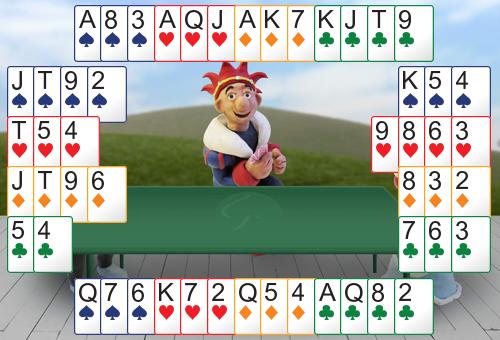
In our final example you are North in 6NT and this time you will need two spade tricks to make your contract.
Be careful with this one! Many players will try a running finesse in this situation by playing the ♠Q and hoping the West has the ♠K.
However, if East has the ♠K your ♠Q will lose and if West has the ♠Q he will simply cover the ♠Q, covering an honour with an honour, with the ♠K forcing you to use your ♠A. Either way you will only make 1 spade trick unless West makes the mistake of not covering your ♠Q.
To win two spade tricks this time you need to play a low spade from the North hand, hoping that East has the ♠K. If East plays low, you play the ♠Q. If East plays the ♠K your ♠Q will make a trick later.
The whole suit!
Instead of looking at just 4 cards, with a suit combination we're looking at the whole suit. For example, AQ876 opposite 5432. How do you make 5 tricks? Should you play the ace hoping the King drops or should you finesse? Why?

If you play the ♠A, hoping to catch the singleton ♠K in the East hand you'll be disappointed! The singleton ♠K in the East hand means West started with SJT9 and you'll still lose a trick. The only way to make 5 tricks is if West has SKx.
So when we say how do you make 5 tricks that's not really the right way to put it because there are actually no guarantees. Better to say how do you mentally position the opposition cards so you can make 5 tricks?
When you're playing a hand and you see a suit combination that you've studied you'll know what to do. It's also very exciting!
There are two reasons to learn suit combinations. The first is that you'll often recognise a suit combination as you're playing and you'll then know how to play the hand.
The second reason to learn suit combinations is that it works your bridge muscles. The more you practice suit combinations the more you'll be able to count your tricks, count your winners and losers, plan your play, figure out where the missing cards are.
AQ76 opposite 432. How do you make 3 tricks? It doesn't matter if you know the answer or not, it's going through the process which is important. You're training yourself to mentally place the cards where you want them.
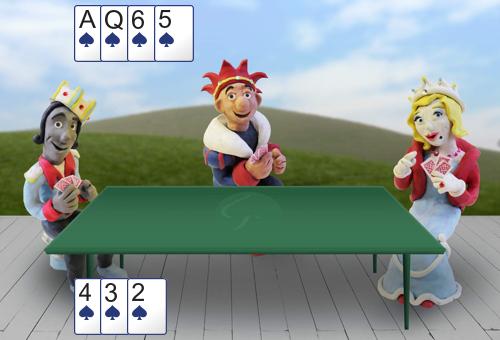
Finesse, hoping that West has Kxx. You'll still need to lose a trick to establish your last card as a winner.
Thinking about each individual suit can also help plan our entries to avoid getting stuck in the wrong hand.
Winning extra tricks by ruffing
We normally win extra tricks by ruffing in the hand that started with fewer trumps.
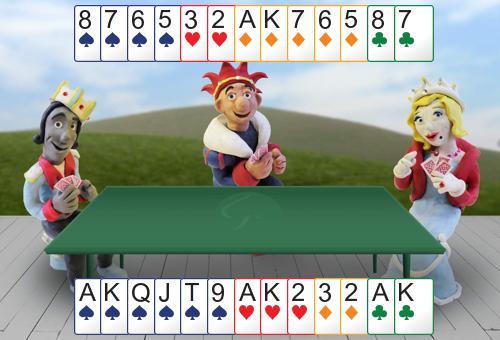
South is declarer in 7♠. There are 6 easy spade tricks, the ♥A, ♥K the ♦A, ♦K and the ♣A, ♣K. That's 12 tricks. Where will the 13th come from?
Declarer could play ♦A, ♦K and ruff a diamond in the South hand but that wouldn't help! We've already counted 6 spade tricks so we'd only be ruffing with a trick we'd already counted as a winner.
However, if declarer plays ♥A, ♥K and ruffs a heart in the North hand we win a trick and we've still got 6 spades in the South hand.
Sometimes we can use a dummy reversal to ruff in the hand long in trumps and draw trumps in the short hand.
Planning the play
At the start of a hand it's a good idea to plan your play. A lot of the time you'll be simply be choosing which of the three techniques we've discussed to use.

Often it'll be a combination and you'll need to decide the order.
tags: #declarerplay
